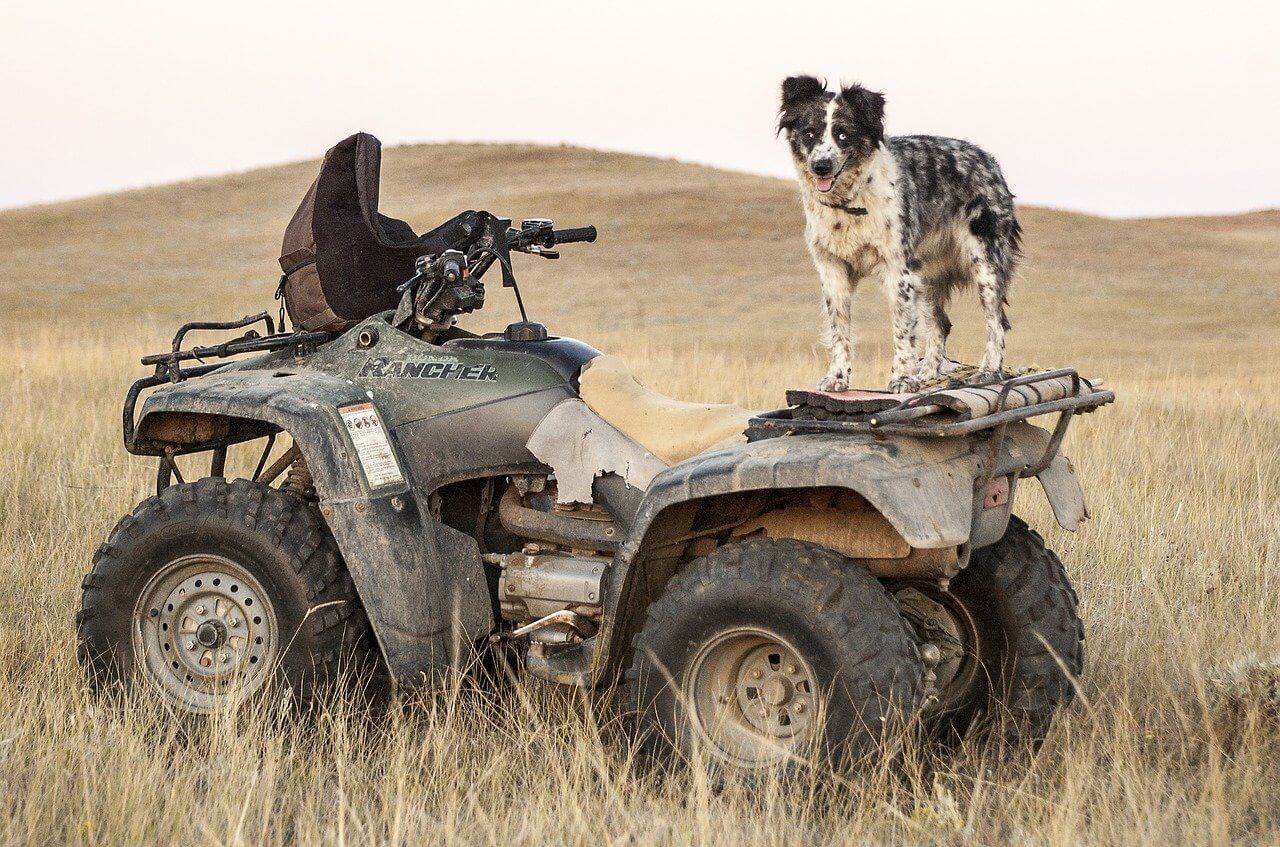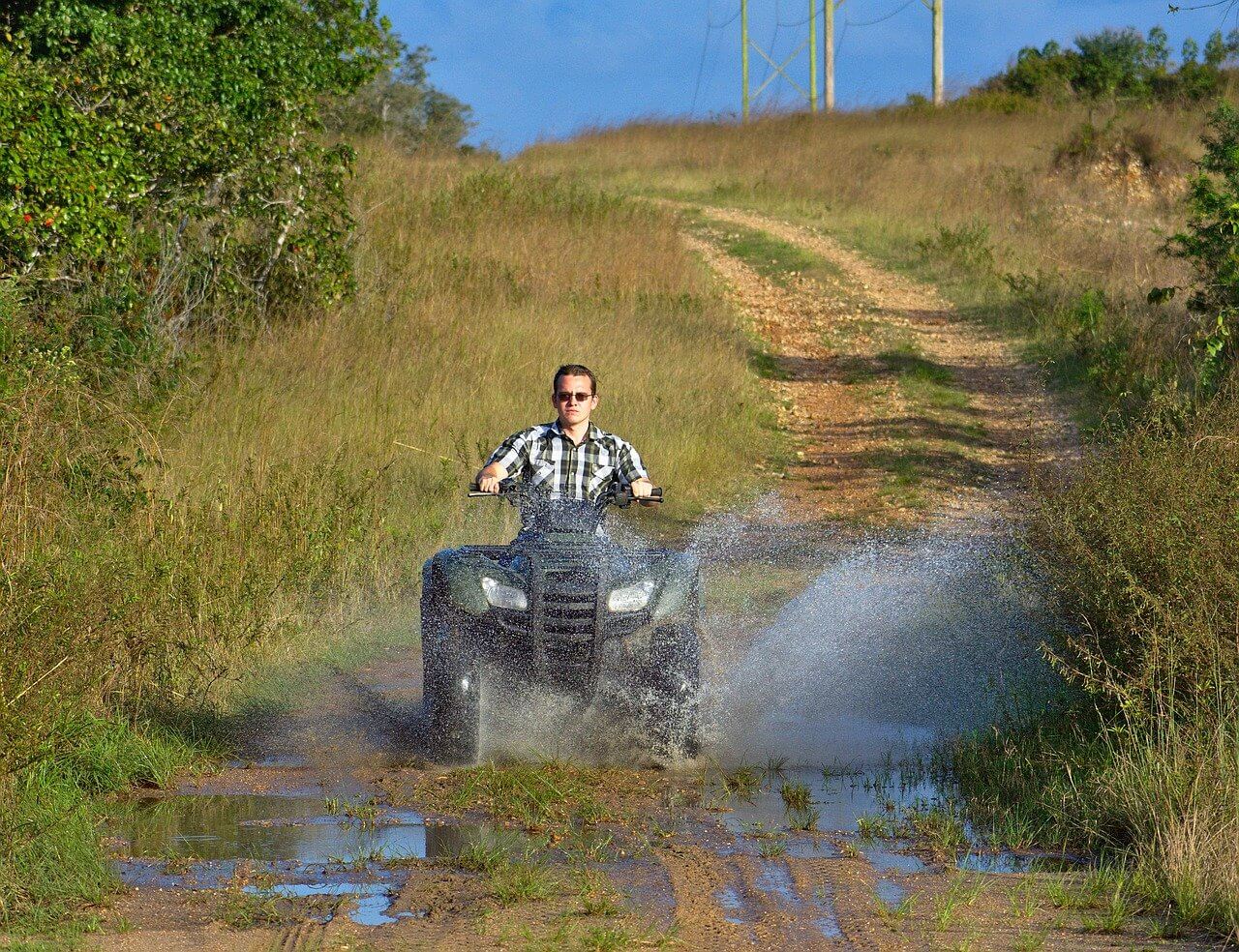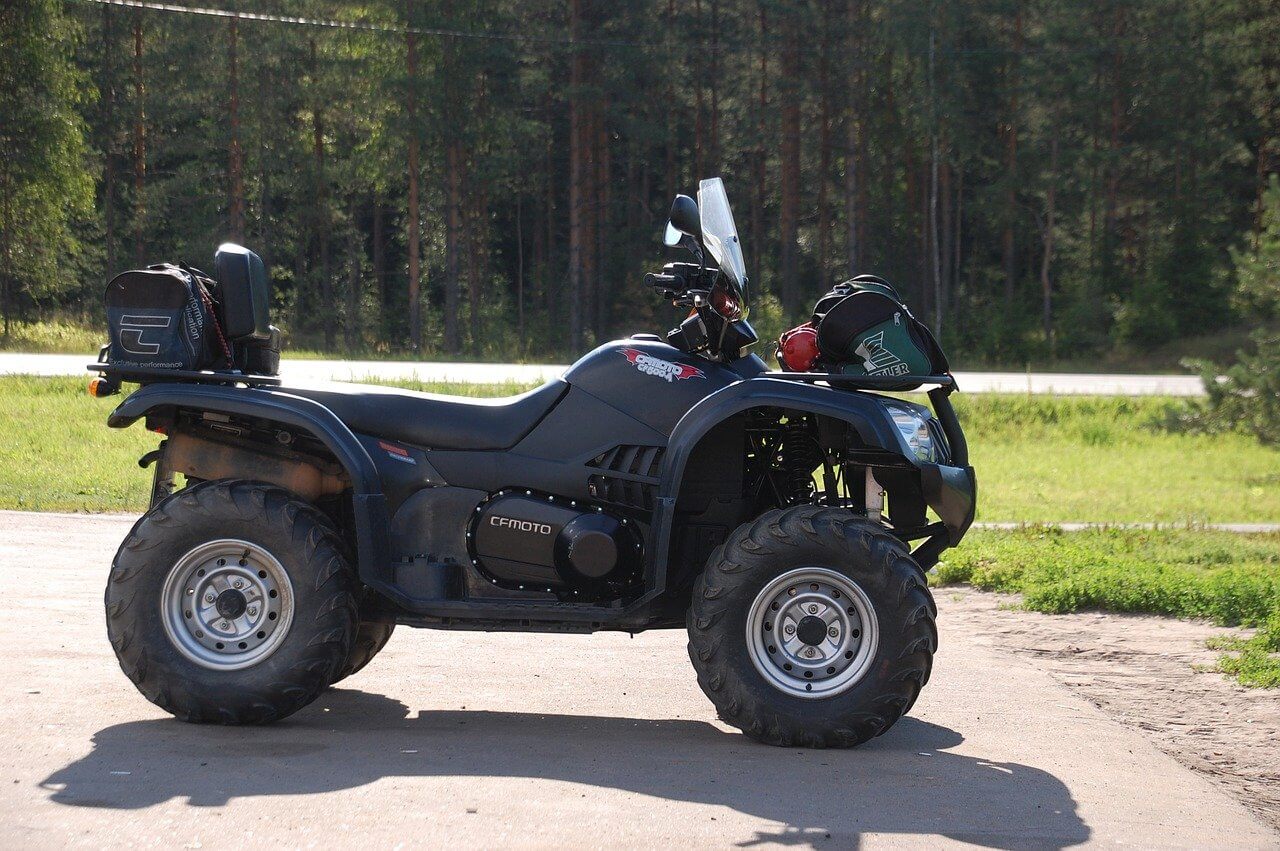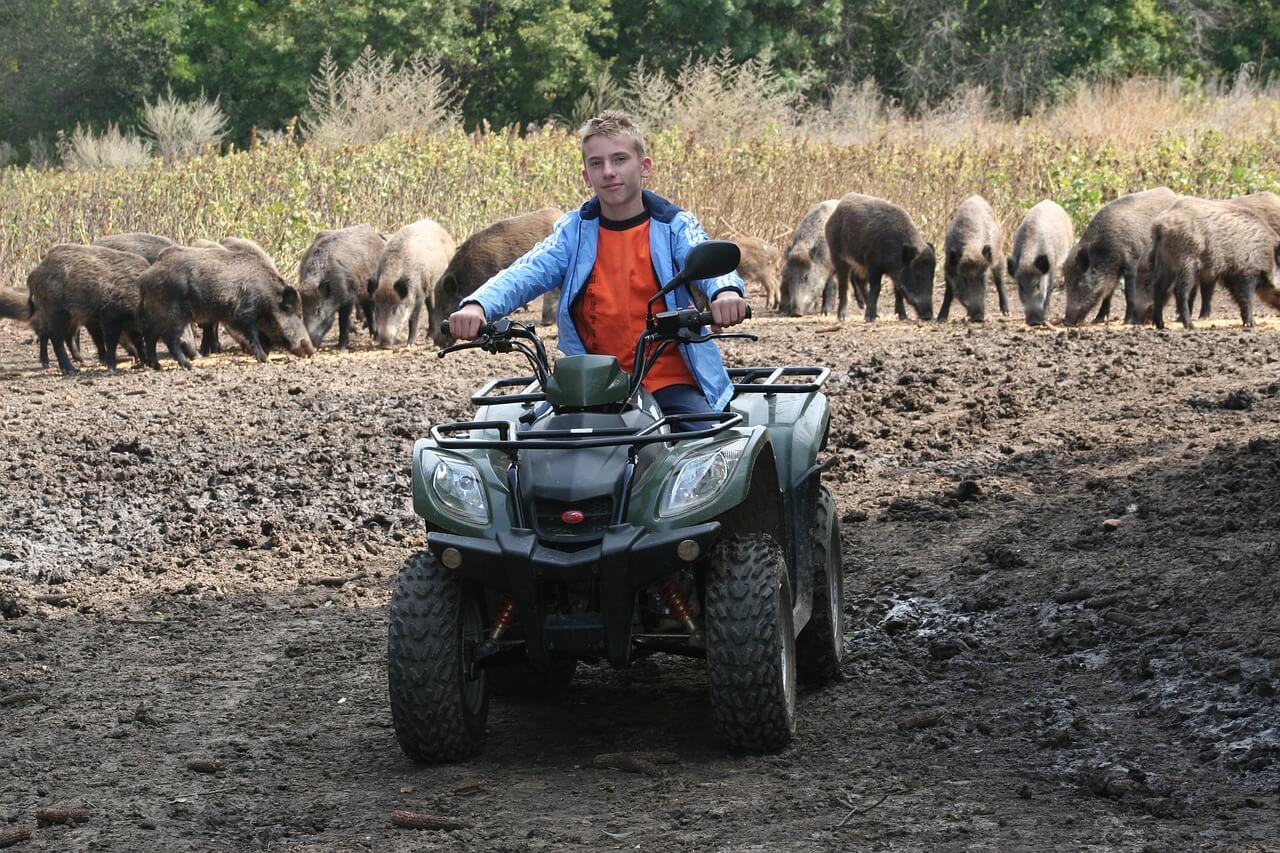Farmers have a range of options when it comes to motorised equipment on their farms.
Tractors are great for power especially for demanding tasks like tilling and transport, but they are pricey. Pickup trucks are fast and powerful, but are pricey and are limited only to mobility and transport.
An alternative option is an ATV. An ATV or all-terrain vehicle is cheaper than a pickup truck or tractor, provides better mobility across different kinds of terrain, and can be applied to a wide range of farming tasks using various attachments.
In this guide, we explain how you can use an ATV for farming, the different types of ATVs, and how to choose the best farming ATV.
What You'll Learn Today
What is an ATV?

An ATV, also called a quad bike, is a 4-wheeled off road vehicle with similar controls to those of a motorcycle. You also ride it like a motorbike.
When they first came out, manufactured first by Honda, ATVs were mostly used recreationally to explore off road trails and by hunters.
In recent years though, farmers have discovered that the features that make ATVs so capable in difficult terrain also make the excellent on the farm.
An ATV can traverse through soil and mud, cross deep ruts, climb over rocks and, with the right skills and experience, go up and down steep slopes.
The wide tires and four wheels of an ATV keeps it stable and reduces the risk of tipping. Controls including throttle and brakes are very similar to those of a motorcycle.
Note that ATVs are not road-legal in most countries. Check your local regulations, but most likely you’ll be limited to riding it within your farm.
Can You Farm With an ATV?

Yes, you can definitely farm with an ATV. Of course, there are limitations and an ATV may not be suitable for certain tasks and situations.
First, let’s look at what you can accomplish on your farm with an ATV.
What You Can Do With an ATV
The most obvious application of an ATV is mobility. It’ll easily and quickly get you from one point to the other. It can access places a tractor or pickup truck cannot, and it uses less fuel.
If you have a sizable farm, an ATV is an easy way to check up on crops and animals, inspect fencing and move around.
ATVs offer much more than mobility on the farm. You can use an ATV as a mini tractor to carry and pull stuff.
To expand the utility of an ATV, you’ll have to get various attachments. Here are the most common ones.
- Plow – A plow is one of the most popular ATV attachments. Attaching a plow to an ATV lets you prepare fields for sowing seeds. Make sure your ATV can handle the weight and power demands of a plow. Other common cultivation ATV attachments include a tiller, disc, and harrow.
- Trailer – Unlike UTVs (which we’ll discuss shortly), ATVs don’t have a bed. Only racks that cannot carry much. A trailer attachment lets you carry bigger and bulkier loads such as hay, wood, fence posts and sacks of produce.
- Lawn mower – For large yards, parks and golf courses, attaching a pull-behind mower to an ATV makes grass maintenance easy.
- Snow plow – A snow plow attachment makes it easy to clear snow from your driveway or farm road.
Other attachments include spreaders, blades, hay dolly and so on. Basically, you can attach whatever you want to your ATV as long as you do not exceed your vehicle’s weight and power limits.
We recommend getting an ATV that’s powerful enough (400cc minimum) to handle a wide range of attachments. It should also be four-wheel drive, use a shaft drive instead of a chain drive, an external oil cooler and disc brakes.
What Can’t You Do With an ATV?
You’ll often find that an ATV can do whatever a tractor can, but at a smaller scale. And that’s the main limitation of ATVs in farming.
They are not as powerful as a tractor. Your ATV cannot carry as much hay, produce, or timber as a tractor. It will also not pull plows, tillers and attachments as big as a tractor can.
If you have a big farm, the smaller tiller or plow attachment of an ATV may slow down work. Consider getting a UTV instead or buying a tractor.
When it comes to mobility, ATVs also have certain limitations. One, almost all ATVs cannot carry passengers. You cannot bring someone else on your farm inspections, unless they have their own ATV or you spend more on a tandem ATV.
Two, ATVs struggle with certain terrain such as very steep slopes.
What Size ATV Do I Need for Farming?

ATVs are sizes based on engine displacement, a measurement you likely know as CC.
ATVs start at 50cc. These are good for kids. They go all the way up to 1000cc. These are suitable for hardcore trail riders and off roaders.
For farming, you’ll want to get an ATV that’s adequate for most farming applications. Even if you don’t plan to pull a tiller with it right away, or carry hay, you may need to do so in the future.
The best ATV size for farmers is 400 to 500cc.
This range gives you adequate speed for mobility, and plenty of power to carry and pull loads. Just as importantly, it ensures the ATV is heavy enough to haul things.
A small ATV such as 250cc or 300cc may be adequate for many farming tasks, but it’ll likely be too light to maintain traction when you are pulling or pushing heavy loads such as plowing snow or pulling a disc.
The weight of an ATV is just as important as its engine size. 400 to 500cc gives you both the power and weight you need for just about any task.
ATVs vs. UTVs
Though almost similar in abbreviation, UTVs are quite different from ATVs. A UTV or a Utility Terrain vehicle is bigger, more powerful, and can haul heavier loads.
UTVs are like small vehicles. In fact, they have the same controls as a vehicle including a steering wheel and brake and throttle pedals. Also, UTVs can sit two people. That’s why they are sometimes called side-by-side. Bigger UTVs can sit three or four people.
The added capability, power and performance of a UTV allows you to do more on your farm. But it has its downsides. One, UTVs are more expensive. Two, UTVs are bigger and are not easily maneuverable on narrow paths and wooded or bushy areas.
Most farmers will do just fine with an ATV. But if you want to pull bigger attachments, or carry more bales of hay, consider upgrading to a UTV.
How Much Does an ATV Cost?

For a utility/farming ATV with a 400cc to 600cc engine, expect to pay between $5,000 and $10,000. The price of specific models depends heavily on which features it is equipped with.
Premium models with added features such as electric power steering, 4×4 mobility, winch, and engine braking can cost up to $2,000 more than the basic model. A tandem (2-seater) ATV will also be significantly more expensive than the common 1-seater models.
Don’t forget to include the cost of various attachments, as well as the cost of ownership (such as insurance, fuel and maintenance).
Luckily, you don’t have to spend a lot of money at once. You can get the ATV first, and then slowly add attachments over time starting with the ones you need most.
How to Ride an ATV
Most people find UTVs much easier to operate compared to ATVs. That’s because a UTV is like your car. You get in and drive.
An ATV, on the other hand, requires a fair amount of skill, similar to riding a motorcycle. Unlike a UTV where you sit and steer, an ATV is rider-active. That means it requires a significant amount of input from the rider in the form of weight shifting.
In other words, you’ll constantly need to move your body around to maintain balance on different kinds of terrain and paths such as going uphill, doing a U-turn and going round a bend.
But before you even get on your quad, you need essential safety gear. That includes a helmet, eye protection, proper boots, gloves, long pants and a long sleeved shirt or, even better, a jacket. ATV accidents tend to be serious, so don’t skimp on protection.
And don’t forget to attach a flag to ensure other people can see you. The low profile of ATVs makes them easy to miss.
Here’s a quick guide from Honda on doing safety checks and safely riding an ATV.
How to Maintain An ATV?
Keeping your ATV in good form is essential both for safety and the longevity of the vehicle. This is especially important on a farm where the ATV is subjected to lots of strain pulling and carrying heavy loads.
You need to regularly check all components of the ATV including the braking, suspension, battery (including stator), and wheels.
You should be able to do basic maintenance and repair checks yourself such as changing an ATV tire, checking oil level, changing the oil, cleaning the ATV carburetor, tightening chain, and washing the ATV (including simple jobs such as restoring faded plastic).
You can leave tougher jobs like adjusting suspension and repairing transmission to your service dealer.
Remember to read the user manual page to page. Check the proper procedure for breaking it in and how to carry out various maintenance tasks. If you want to go even further, ask the dealer for the service manual, the same one mechanics consult when working on the ATV.
If you are buying a used ATV, make sure you get a full service history and ask the owner for problematic parts you should know about.
Can You Drive a Farm Quad on the Road?
In most places, you cannot drive a farm ATV on the road. That’s because farm quads do not meet road safety standards, thus you cannot ride on the highway or any public road.
You are limited to the roads within your farm, as well as approved trails. In some jurisdictions, quad bikes are allowed to cross the road, or can drive on public roads for a limited distance at a limited speed.
In other places like the UK, you can buy a road-legal bike but you’ll need a driver’s license, DVLA registration, an MOT certificate, and third party insurance to use it on the road.
We recommend checking your local regulation in regards to owning and riding a quad bike. The good news is that in most cases, you can buy and ride an ATV within your farm without having to register it or get a license. It’s up to you whether to insure it.
How Fast Can an ATV Go?

The speed of an ATV depends mostly on its engine size. The higher the CC, the faster it can go.
Sports ATVs are the fastest. 1000cc ATVs can hit speeds up to 80 MPH (128 km/h). Farming/utility ATVs between 400cc and 600cc reach speeds of between 55 and 65 MPH.
Smaller youth and kids ATVs are much slower at around 30 MPH or less.
But engine size is not the only factor determining speed. Weight matters too. If you are just going on a farm inspection without carrying anything, you can move pretty fast.
If you are carrying bales of hay or a pile of wood, you are going to be much slower. An attachment such as a plow will slow you down even more.
Fortunately, speed is not that important for a farm ATV. If anything, you want to go slow to avoid accidents.
One of the most common aftermarket modifications for ATVs is gear reduction. It reduces the unwanted speed, and converts it into much more useful torque. This increases your pulling power.
Farming With an ATV: Bottom Line
While an ATV cannot fully replace a tractor, it is an excellent option for small and medium size farm owners who cannot afford the cost of a tractor. You can also use an ATV alongside a tractor and a pickup truck.
With the fast progress that’s been happening in the ATV industry, in terms of power, performance, and features, you’ll be surprised at how much you can accomplish with an ATV in your farm. Get the right attachments, and you can do just about any farming task with a humble quad bike.
interested